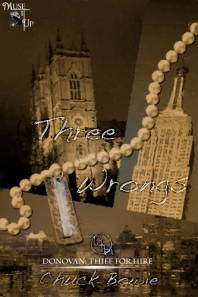How do you write a novel with multiple story lines? Today author Chuck Bowie is here with a guest post on how to knit separate story lines into a cohesive whole, without disrupting the flow of each narrative, and at the same time intensifying the themes of your novel.
Carrying Multiple Arcs Across a Novel
 Good guy acquires a quest. Good guy meets bad guy. Good guy surmounts trials and all’s well that ends well. How many of us have read (and enjoyed) a great written journey that went along those lines? I wish I had a brain that was wired in such a manner. Life for a writer would be so much simpler, if we could just follow a path—the Yellow Brick Road, for example—to the happy ending.
Good guy acquires a quest. Good guy meets bad guy. Good guy surmounts trials and all’s well that ends well. How many of us have read (and enjoyed) a great written journey that went along those lines? I wish I had a brain that was wired in such a manner. Life for a writer would be so much simpler, if we could just follow a path—the Yellow Brick Road, for example—to the happy ending.
But no. We’re not programmed to make our own lives that easy.
There must be trouble and strife, right? We get to page twelve and this little girl appears. Who invited her to the party? And why is she here? Ah. She brings with her an amazing tale. And, while that tale is amazing and completely out of the blue, it seems, ‘way down the road, to be tied to your original plotline. Who knew?
So. There you are with a great, straightforward story, you’ve made it to page twelve, and a peripherally-related story comes along. Do you a) save it for another day, another story? b) ignore it; perhaps accusing it of trying to detract you from your original purpose? Or, do you c) begin a new chapter in the hope that this little girl will make your original plot richer, with loose ends tied up in the loveliest way?
In my suspense-thriller, Three Wrongs, my protagonist, Sean Donovan, is a thief for hire. As the novel begins, he’s in Romania and he’s been hired to steal a chalice. While he’s there, he stumbles across a government scam and asks himself: “How can I get a bit of the money that seems to be lying around?” He is a thief, after all. But someone dies who isn’t supposed to and he becomes intent on addressing this unfair tragedy.
In subsequent chapters, Donovan steals other things, but that is part of the original storyline arc. The complications ensue when he begins to notice the impact his thefts are having on people he historically wouldn’t have cared about. This throws him off his game and he begins to chase down quests—the other arcs—that he never would have cared about previously. He’s beginning to change. It’s in the secondary arcs that we see this change and growth.
As a writer, it is critical to be absolutely confident that these ancillary arcs complement the original plot, or else, why include them? They can be as interesting as can be, but if they don’t push the narrative along, the reader will grow impatient with this extraneous driftwood while reading the novel, and downright resentful when they see loose ends at the denouement.
It’s like knitting. A single strand of wool will not make a sweater. The strand needs to become entwined with other, similar strands, to accomplish the task. ‘Similar’ is the operative word. The colours and textures really do need to be consistent with the main arc, in order that the story is told well.
How many primary arcs can one novel sustain? In Three Wrongs, I had clearly a single, primary arc. My man Donovan commits three thefts, and then attempts to undo them. Again, straightforward. In book two of the series: AMACAT, the arcs aren’t as clean. Donovan’s friend is murdered and, in the end, Donovan attempts to resolve it. However, more time is spent on a completely different quest. He must get an acquaintance out of a jam. In my second novel the distinction between which is the primary arc blurs. In this case, care must be taken to keep the reader well-informed, chapter-by-chapter, as to which arc they are getting caught up on.
There are tricks to keep the reader current on each arc storyline. The beginning of every chapter has to spell out which arc it is and which characters will be profiled. And as the chapter unfolds, exposition, dialogue and description all have to mean something to the evolution of the main story.
By novel’s end, each arc has to be resolved. Every character’s role, good or evil, has to be played out to a satisfactory conclusion. Taking it even farther, each arc has to complement and strengthen the primary narrative arc. The reader has to be left with the feeling that they understand what happened. In the best knitting of arcs, the reader is left feeling that they gathered up numerous events into a cohesive story that made sense. Each mini story, each arc, did its job to push the story from quest to journey to crisis, to its conclusion. All roads lead to Rome, and all of a story’s arcs lead to a satisfactory ending.
* * * *
Chuck Bowie is an author with MuseItUp Publishing. His eBook Three Wrongs is now available from the Muse Bookstore and other major etailers. He’s just finishing the second in the series Donovan: Thief For Hire. It’s called AMACAT, an acronym for the three arcs of the story.
*
Thanks for the great post, Chuck.
It’s not easy switiching between story arcs without disorientating the reader. I recently read Christina Dyer Hickey’s Last Train to Liguria, which switches alternately from a present-day storylline to one set in the second world war. It was a great read, and kept me gripped throughout.
Do you have any questions or comments for Chuck? Have you read any novels with several storylines that you can recommend? If you’re a writer, have you ever attempted such a novel? Please let us know in the comments. We’d love to hear from you!



Leave a Reply